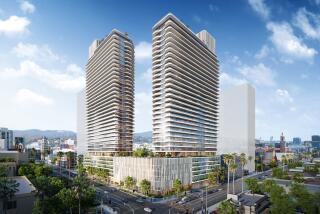Boon, Bust Pictures Are Painted for Housing Plan
- Share via
MOORPARK — A proposed 3,221-home development near Moorpark College could be a financial boon to the city, bringing added property- and sales-tax receipts to city coffers.
Or it could become an economic burden, bleeding the city for such services as police and fire protection while supplying too little tax money to pay for them.
According to a report released late Friday, the Hidden Creek Ranch development’s impact on Moorpark hinges largely on two elements: shopping and taxes. If enough shops and stores are built within the project during the right time frame, the development should pay for itself, supplying more than enough tax revenues to cover city services and expenses.
If, however, too few stores are built and if the county gives the city too small a portion of the property-tax receipts from the project, Hidden Creek could cost the city as much as $278,000 annually.
Jeff Gordon, senior vice president of Messenger Investment Co. of Irvine, which proposed the project, declined to comment on the report’s findings, saying he had not yet read the study. But he said the additional families the project would bring to Moorpark would benefit the city.
“When you get 3,000 households over 15 years, using their disposable income to buy things in Moorpark, it’s going to bring in a lot of sales tax,” he said.
The study is a key part of the city’s ongoing review of the project. Moorpark’s Planning Commission on Monday will hold the latest in a series of hearings on the project, which encompasses more than 4,300 acres on the city’s northeastern edge. In addition to housing several thousand residences, the development would create about 325,000 square feet of retail space for shops and restaurants.
Assembled by consultants Ralph Andersen & Associates of Sacramento, the study analyzed several scenarios for how the development might proceed. Some included the full amount of projected retail space. Another included a lesser amount, 180,000 square feet, while a third assumed that no commercial development would occur.
Without the full complement of commercial development, the study found, the project may not be able to pay its way.
Even more important than the shops, however, is the volume of property-tax revenue the city would receive from Hidden Creek. The project site is just outside the city limits. Development plans call for the property to be annexed by the city if the project is approved.
In annexing the property, city officials would have to negotiate with the county to determine what share of the property-tax receipts would go to Moorpark. The city now receives 7.9% of the tax from land within its limits.
But in recent negotiations, the county has given cities as little as 3.2%. The study, therefore, used that lower figure as the basis for many of its projections.
“It would be half of our current property-tax rate,” Assistant City Manager Richard Hare said. “So when you consider that property tax [alone] doesn’t cover the cost of providing services, you see the development really doesn’t pay.”
But if the city were to receive 7.9% of the property tax, Hidden Creek would have a positive financial impact under all of the study’s development scenarios.
More to Read
Sign up for Essential California
The most important California stories and recommendations in your inbox every morning.
You may occasionally receive promotional content from the Los Angeles Times.





